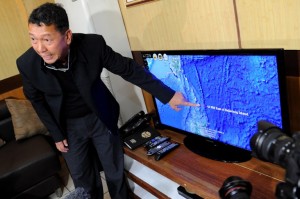
Philippine Bureau of Fisheries and Aquatic Resources director Asis Perez points to a map in Manila on May 10, 2013, showing where a Philippine fisheries patrol vessel manned by the coast guard shot at a Taiwanese fishing vessel the day before near Balintang island in the northern Philippines. The Philippine coastguard admitted on May 10 that its personnel shot at a Taiwanese fishing boat in an incident that authorities in Taipei said left a crewman dead. AFP FILE PHOTO/Jay DIRECTO
MANILA, Philippines—It was self-defense.
That’s how Philippine Coast Guard officers aboard a Bureau of Fisheries and Aquatic Resources (BFAR) vessel described their action during an encounter with a Taiwanese fishing boat off Balintang Island in northern Philippines last week.
The coast guards submitted their report on the encounter to their commander, Rear Adm. Rodolfo Isorena, a copy of which has been submitted to the National Bureau of Investigation (NBI), which President Benigno Aquino III has ordered to look into the circumstances of the May 9 incident that led to the shooting death of Taiwanese fisherman Hung Shih-cheng and to new tensions between Taiwan and the Philippines.
A source who has knowledge of the investigation told the Inquirer yesterday that the coast guards and two BFAR employees aboard the surveillance vessel MCS-3001 admitted firing on the Taiwanese fishing boat Guang Ta Hsin 28, but only in “self-defense.”
“The fishing boat with passengers speaking a foreign language approached at full speed and attempted to ram the Philippine vessel, but the bigger [BFAR] vessel was able to [maneuver and the fishing boat missed it by a meter],” the source said.
There had been warnings from the Coast Guard before that, the source said.
The coast guards heard on their radio an instruction in “a foreign language” then the fishing boat sped toward the MCS-3001.
Warning shot
Using their vessel’s public address system, the coast guards ordered the fishing boat to stop, the source said.
“But the fishing boat did not heed the order and continued to speed toward the Philippine vessel, forcing it to fire a warning shot,” the source said.
Then the near-miss, and a shirtless crew member of the fishing boat coming out on deck and making motions as if daring the coast guards to come after his boat, the source said.
The fishing boat sped off and the MCS-3001 went after it, firing at the boat’s engine to stop the vessel.
But the coast guards gave up the chase when they saw eight to 10 more fishing boats where the Guang Ta Hsin 28 was headed.
It is unclear whether the shirtless man who taunted the coast guards was Hung and how the fisherman was hit.
But the Taiwanese government is demanding, among other things, a formal apology from the Philippine government for Hung’s death, compensation for the fisherman’s family, and the arrest and punishment of the killers.
To pressure the Philippines, Taiwan froze the hiring of Filipino workers.
President Aquino sent a letter to the Taiwanese government on Wednesday, but Taipei rejected it for being “insincere” and suspended official and trade exchanges, economic cooperation projects, tourist travel to the Philippines, and staged naval exercises in waters near the Philippines to show its anger over the killing of Hung.
Drill ignored
Malacañang ignored the naval exercises, which it said on Friday were held outside Philippine territory.
“As long as the activity is within their borders, or in the high seas, then that should not be a concern for us,” deputy presidential spokesperson Abigail Valte told reporters.
But she said the government was preparing for “contingencies” following Taiwan’s imposition of retaliatory measures on the Philippines.
Valte said the Department of Labor and Employment was looking at “alternative markets” for Filipino workers whose job applications had been frozen.
Valte said the Philippine government had “done enough” by apologizing for Hung’s death. But she said she did not know how Mr. Aquino took Taiwan’s rejection of his apology.
Avoiding escalation
Asked about China’s backing Taiwan in this controversy, Valte said the President had given instructions to “avoid escalation.”
Malacañang also ignored the arrival of Taiwanese investigators on Wednesday to join the Philippine investigation of the incident.
Valte quoted Justice Secretary Leila de Lima as saying that the Taiwanese investigators first have to make arrangements with the Manila Economic and Cultural Office in Taipei before coming to Manila.
De Lima yesterday said the Taiwanese investigators were free to investigate the killing of Hung, but how much access they would be allowed here depended on how much access NBI investigators would be given in Taiwan for their own investigation of the circumstances surrounding Hung’s death.
The NBI is sending a team to Taiwan to talk to the crew of the Guang Ta Hsin 28 and inspect the boat as part of the Philippine investigation.
No joint probe
“We shall see up to what extent the cooperation between the two investigative teams would be. But it’s not going to be a joint [probe],” De Lima said.
“We can allow them to inspect the Philippine Coast Guard-Bureau of Fisheries and Aquatic Resources vessel. But they should also allow us to inspect the Taiwanese fishing vessel, and, if possible, [the inspections should be] simultaneous,” she added.
NBI Director Nonnatus Rojas and Virgilio Mendez, the bureau’s deputy director for regional services and leader of the investigative team, presented at a news conference yesterday 15 high-powered firearms used by the coast guards during the encounter with the Taiwanese fishing boat.
The NBI officials, however, declined to go into specifics, just saying that the coast guards claimed “provocation.”
Video of encounter
Mendez confirmed that the NBI has a video of the encounter at sea, but the authenticity of the video had yet to be established.
“We want to interview the person who took that video first, and determine if it is really relevant to this investigation,” Mendez said. With reports from Michael Lim Ubac and Jerome Aning

